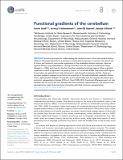| dc.contributor.author | Schmahmann, Jeremy D | |
| dc.contributor.author | Guell Paradis, Xavier | |
| dc.contributor.author | Gabrieli, John D. E. | |
| dc.contributor.author | Ghosh, Satrajit S | |
| dc.date.accessioned | 2018-10-23T11:51:08Z | |
| dc.date.available | 2018-10-23T11:51:08Z | |
| dc.date.issued | 2018-08 | |
| dc.date.submitted | 2018-03 | |
| dc.identifier.issn | 2050-084X | |
| dc.identifier.uri | http://hdl.handle.net/1721.1/118747 | |
| dc.description.abstract | A central principle for understanding the cerebral cortex is that macroscale anatomy reflects a functional hierarchy from primary to transmodal processing. In contrast, the central axis of motor and nonmotor macroscale organization in the cerebellum remains unknown. Here we applied diffusion map embedding to resting-state data from the Human Connectome Project dataset (n = 1003), and show for the first time that cerebellar functional regions follow a gradual organization which progresses from primary (motor) to transmodal (DMN, task-unfocused) regions. A secondary axis extends from task-unfocused to task-focused processing. Further, these two principal gradients revealed novel functional properties of the well-established cerebellar double motor representation (lobules I-VI and VIII), and its relationship with the recently described triple nonmotor representation (lobules VI/Crus I, Crus II/VIIB, IX/X). Functional differences exist not only between the two motor but also between the three nonmotor representations, and second motor representation might share functional similarities with third nonmotor representation. | en_US |
| dc.description.sponsorship | la Caixa Foundation | en_US |
| dc.description.sponsorship | National Institutes of Health (U.S.) (grant R01 EB020740) | en_US |
| dc.description.sponsorship | National Institutes of Health (U.S.) (grant P41 EB019936) | en_US |
| dc.publisher | eLife Sciences Publications, Ltd. | en_US |
| dc.relation.isversionof | http://dx.doi.org/10.7554/eLife.36652 | en_US |
| dc.rights | Creative Commons Attribution 4.0 International License | en_US |
| dc.rights.uri | http://creativecommons.org/licenses/by/4.0/ | en_US |
| dc.source | eLife | en_US |
| dc.title | Functional gradients of the cerebellum | en_US |
| dc.type | Article | en_US |
| dc.identifier.citation | Guell, Xavier, Jeremy D Schmahmann, John DE Gabrieli, and Satrajit S Ghosh. “Functional Gradients of the Cerebellum.” eLife 7 (August 14, 2018). | en_US |
| dc.contributor.department | Harvard University--MIT Division of Health Sciences and Technology | en_US |
| dc.contributor.department | Massachusetts Institute of Technology. Clinical Research Center | en_US |
| dc.contributor.department | Massachusetts Institute of Technology. Department of Brain and Cognitive Sciences | en_US |
| dc.contributor.department | Massachusetts Institute of Technology. Research Laboratory of Electronics | en_US |
| dc.contributor.department | McGovern Institute for Brain Research at MIT | en_US |
| dc.contributor.mitauthor | Guell Paradis, Xavier | |
| dc.contributor.mitauthor | Gabrieli, John D. E. | |
| dc.contributor.mitauthor | Ghosh, Satrajit S | |
| dc.relation.journal | eLife | en_US |
| dc.eprint.version | Final published version | en_US |
| dc.type.uri | http://purl.org/eprint/type/JournalArticle | en_US |
| eprint.status | http://purl.org/eprint/status/PeerReviewed | en_US |
| dc.date.updated | 2018-10-22T19:26:50Z | |
| dspace.orderedauthors | Guell, Xavier; Schmahmann, Jeremy D; Gabrieli, John DE; Ghosh, Satrajit S | en_US |
| dspace.embargo.terms | N | en_US |
| dc.identifier.orcid | https://orcid.org/0000-0003-1158-5692 | |
| dc.identifier.orcid | https://orcid.org/0000-0002-5312-6729 | |
| mit.license | PUBLISHER_CC | en_US |
